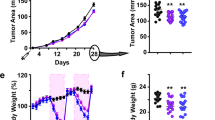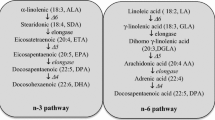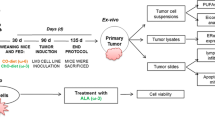Abstract
We wanted to examine the effects of an oil rich in docosahexaenoic acid (DHA), without eicosapentaenoic acid, on the composition of membrane phospholipid in a variety of tissues. Our in vitro studies had previously shown that DHA could modify glucose and nucleoside transport in cells in culture and also increase selectivity of the nucleoside drug, arabinosylcytosine (araC) toward tumor cells. Here we wanted to examine what effect DHA supplementation would have in the whole animal in terms of the chemosensitivity of normal bone marrow, the dose-limiting tissue during chemotherapy, to araC. The purpose was to determine whether fatty acid supplementation might be useful as an adjuvant to chemotherapy. We fed diets containing 5% (w/w) low fat-corn oil (LF-CO group), 10% moderate fat-safflower oil (MF-SO group), or 10% DHASCOTM (MF-DHA group) to weanling Fischer 344 rats for 8–9 wk. Feed intake and growth were not different between the different diets. Similarly, treatment of animals with the chemotherapeutic drug araC did not differentially affect growth, feed intake, or tissue fatty acid composition for the different diet groups. Fatty acid compositions of bone marrow, liver, red blood cells, plasma phospholipid and triglyceride, as well as skeletal and cardiac muscle, were substantially different between the dietary groups. The DHASCOTM oil contained 46% DHA (22:6n-3) and resulted in profound incorporation of DHA in all tissues examined. The most dramatic response was seen in skeletal muscle of MF-DHA fed animals where DHA represented 46% of membrane phospholipid fatty acids. This is likely to have consequences to muscle function. Although DHASCOTM contains a similar level of saturated fatty acids (42%), few differences in saturates were noted between the various dietary groups for most of the tissues examined. Both LF-CO and MF-SO diets were hypercholesterolemic, and the LF-CO was also hypertriglyceridemic compared to the chow-fed animals. Animals fed the MF-DHA diet had the lowest triglyceride levels of any of the treatment groups and cholesterol levels comparable to chow-fed animals. MF-DHA had substantially higher numbers of colony-forming units-granulocyte macrophage (CFU-GM) as reflected in a twofold higher bone marrow cellularity than either chow or LF-CO animals, suggesting expansion of the bone marrow compartment with DHA feeding. Although higher than LF-SO, the number of CFU-GM in MF-SO animals was not significantly higher than animals fed chow. Bone marrow from LF-CO animals appeared to be more resistant to araC treatment than either MF group. Thus, DHA, fed as DHASCOTM, has advantages over low or moderate n-6 diets and chow as it is has both hypolipidemic- and bone marrow-enhancing properties in weanling Fischer 344 rats. This suggests that DHA supplementation may be useful in adjuvant chemotherapy.
Similar content being viewed by others
Abbreviations
- AA:
-
arachidonic acid
- araC:
-
arabinosylcytosine
- DHA:
-
docosahexaenoic acid
- DPA:
-
docosapentaenoic acid
- DTA:
-
docosatetraenoic acid
- EPA:
-
eicosapentaenoic acid
- FBS:
-
fetal bovine serum
- IMDM:
-
Iscove’s Modified Dulbecco’s Medium
- LA:
-
linoleic acid
- LF-CO:
-
low fat corn oil
- MF-SO:
-
moderate fat safflower oil
- OA:
-
oleic acid
- PBS:
-
phosphate buffered saline
- PUFA:
-
polyunsaturated fatty acids
References
Blot, W.J., Lanier, A., Fraumeni, J.F., and Bender, T.R. (1975) Cancer Mortality Among Alaskan Natives, 1960–69, J. Natl. Cancer Inst. 55, 547–554.
Fernandes, G., and Venkatraman, J.T. (1993) Role of Omega-3 Fatty Acids in Health and Disease, Nutr. Res. 13, S19-S45.
Karmali, R.A., Marsh, J., and Fuchs, C. (1983) Effect of Omega-3 Fatty Acids on Growth of a Rat Mammary Tumor, J. Natl. Cancer Inst. 71, 601–605.
Harris, W.S. (1996) n-3 Fatty acids and Lipoproteins: Comparison of Results from Human and Animal Studies, Lipids 31, 243–252.
Boreson, C.E., Pardini, L., Pardini, R.S., and Reitz, R.C. (1989) Effects of Dietary Fish Oil on Human Mammary Carcinoma and on Lipid-Metabolizing Enzymes, Lipids 24, 290–295.
Fritsche, K., and Johnston, P.V. (1990) Effect of Dietary α-Linolenic Acid on Growth, Metastasis, Fatty Acid Profile and Prostaglandin Production of Two Murine Mammary Adenocarcinomas, J. Nutr. 120, 1601–1609.
Tisdale, M.J., and Dhesi, J.K. (1990) Inhibition of Weight Loss by ω-3 Fatty Acids in an Experimental Cachexia Model, Cancer Res. 50, 5022–5026.
Sakaguchi, M., Imray, C., Davis, A., Rowley, S., Jones, C., Lawson, N., Keighley, M.R.B., Baker, P.R., and Neoptolemos, J.P. (1990) Effects of Dietary n-3 and Saturated Fats on Growth Rates of the Human Colonic Cancer Cell Lines Sw-620 and Ls 174 T in vivo in Relation to Tissue and Plasma Lipids, Anti-cancer Res. 10, 1763–1768.
Reddy, B.S., Burill, C., and Rigotty, J. (1991) Effect of Diets High in ω-3 and ω-6 Fatty Acids on Initiation and Postinitiation Stages of Colon Carcinogenesis, Cancer Res. 51, 487–491.
Man-Fan Wan, J., Kanders, B., Kowackuk, M., Knapp, H., Szeluga, D.J., Bagley, J., and Blackburn, G.L. (1991) ω-3 Fatty Acids and Cancer Metastasis in Humans, World Rev. Nutr. and Diet. 66, 477–487.
Uauy-Dagach, R., and Balenzuela, A. (1992) Marine Oils as a Source of Omega-3 Fatty Acids in the Diet: How to Optimize the Health Benefits, Prog. Food Nutr. Sci. 16, 199–243.
Tisdale, M.J., and Beck, S.A. (1991) Inhibition of Tumour-Induced Lipolysis in vivo by Eicosapentaenoic Acid, Biochem. Pharmacol. 41, 103–107.
Hudson, E.A., Beck, S.A., and Tisdale, M.J. (1993) Kinetics of the Inhibition of Tumour Growth in Mice by Eicosapentaenoic Acid-Reversal by Linoleic Acid, Biochem. Pharmacol. 45, 2189–2194.
Connolly, J.M., and Rose, D.P. (1993) Effects of Fatty Acids on Invasion Through Reconstituted Basement Membrane (“Matrigel”) by a Human Breast Cancer Cell Line, Cancer Lett. 10, 137–142.
Falconer, J.S., Ross, J.A., Fearon, K.C., Hawkins, R.A., O’Riordain, M.G., and Carter, D.C. (1994) Effect of Eicosapentaenoic Acid and Other Fatty Acids on the Growth in vitro of Human Pancreatic Cancer Cell Lines, Br. J. Cancer 69, 826–832.
Blackmore, V., and Meckling-Gill, K.A. (1995) Fish Oil and Oleic Acid Rich Oil Feeding Alter Nucleoside Transport in Human Erythrocytes, J. Nutr. Biochem. 6, 438–444.
de Salis, H., and Meckling-Gill, K.A. (1995) EPA and DHA Alter Nucleoside Drug and Adriamycin Toxicity in L1210 Leukemia Cells But Not in Normal Bone Marrow Derived S1 Macrophages, Cell. Pharmacol. 2, 69–74.
Atkinson, T.G, and Meckling-Gill, K.A. (1995) Regulation of Nucleoside Drug Toxicity by Transport Inhibitors and Omega-3 Polyunsaturated Fatty Acids in Normal and Transformed Rat-2 Fibroblasts, Cell. Pharmacol. 2, 259–264.
Jamieson, D.D. (1991) Lipid Peroxidation in Brain and Lungs from Mice Exposed to Hyperoxia, Biochem. Pharmacol. 41, 749–756.
Bligh, E.G., and Dyer, W.J. (1959) A Rapid Method of Total Lipid Extraction and Purification, Can. J. Biochem. Physiol. 37, 911–917.
Holub, B.J., and Skeaff, C.M. (1987) Nutritional Regulation of Cellular Phosphatidylethanolamine, Methods Enzymol. 141, 234–244.
Ikeda, I., Wakanatsu, K., Ainayoshi, A., Imaizumi, K., Sugano, M., and Yazawa, K. (1994) α-Linolenic, Eicosapentaenoic and Docosahexaenoic Acids Affect Lipid Metabolism Differently in Rats, J. Nutr. 124, 1898–1906.
Willumsen, N., Hexeberg, S., Skorve, J., Lundquist, M., and Berge, R.K. (1993) Docosahexaenoic Acid Shows No Triglyceride-Lowering Effects But Increases the Peroxisomal Fatty Acid Oxidation in Liver of Rats, J. Lipid Res. 34, 13–22.
Garg, M.L., Thomson, A.B.R., and Clandinin, M.T. (1989) Hypotriglyceridemic Effect of Dietary n-3 Fatty Acids in Rats Fed Low Versus High Levels of Linoleic Acid, Biochim. Biophys. Acta 1006, 127–130.
Nagy, L.E., Atkinson, T.G., and Meckling-Gill, K.A. (1996) Feeding Docosahexaenoic Acid Impairs Hormonal Control of Glucose Transport in Rat Adipocytes, J. Nutr. Biochem. 7, 356–363.
Martin, D., and Meckling-Gill, K.A. (1996) Omega-3 Polyunsaturated Fatty Acids Increase Purine But Not Pyrimidine Transport in L1210 Leukemia Cells, Biochem. J. 315, 329–333.
Burns, C.P., and Spector, A.A. (1990) Effects of Lipids on Cancer Therapy, Nutr. Rev. 48, 233–240.
Burns, C.P., Rosenberger, J.A., and Luttenegger, D.G. (1983) Selectivity in Modification of the Fatty Acid Composition of Normal Mouse Tissues and Membranes in vivo, Ann. Nutr. Metab. 27, 268–277.
Boswell, K., Carl, L., Koskelo, E.-K., and Kyle, D. (1995) Preclinical Evaluation of Designer Oils Which Are Highly Enriched in Docosahexaenoic and Arachidonic Acid, FASEB J. 9, A475.
Author information
Authors and Affiliations
About this article
Cite this article
Atkinson, T.G., Barker, H.J. & Meckling-Gill, K.A. Incorporation of long-chain n-3 fatty acids in tissues and enhanced bone marrow cellularity with docosahexaenoic acid feeding in post-weanling Fischer 344 rats. Lipids 32, 293–302 (1997). https://doi.org/10.1007/s11745-997-0036-x
Received:
Revised:
Accepted:
Issue Date:
DOI: https://doi.org/10.1007/s11745-997-0036-x




